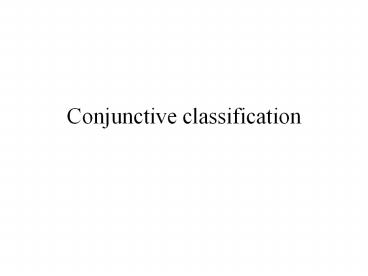Conjunctive classification - PowerPoint PPT Presentation
1 / 9
Title:
Conjunctive classification
Description:
In conjunctive classification, we want our model to give each item a score as a ... A prototype is a list of weighted attribute-values. ... – PowerPoint PPT presentation
Number of Views:35
Avg rating:3.0/5.0
Title: Conjunctive classification
1
Conjunctive classification
2
What is conjunctive classification?
In single-category classification, we want our
model to give each test item to be classified a
score as a member of each single category. Test
item ltABYgt ? 0.6
as a member of A,
0.5 as a member of B,
0.3 as a member of C. In conjunctive
classification, we want our model to give each
item a score as a member of each conjunction or
ANDED-PAIR of categories. Test item ltABYgt ?
??? as a member of AB
(member of both A and B),
??? as a member of AC (member of both A
and C), ??? as a
member of AC (member of both A and C). How do
we work out membership in a conjunction AB?
3
Conjunction models
Independent prototype model Membership in single
categories is computed by additive
weighted-attribute prototype similarity (as
before) To compute an items membership in a
conjunction AB, combine that items computed
membership in A and its computed membership in
B. What functions can be used to combine
constituent membership? membership(x, AB)
product(A,B)
membership(x,A)membership(x,B).
4
Other functions
membership(x, AB) average(A,B)
(membership(x,A)membership
(x,B)) / 2. membership(x, AB) minimum(membership
(x,A)membership(x,B)) membership(x, AB)
sum(A,B)
(membership(x,A) membership(x,B))
membership(x, AB) normalised sum (A,B)
(membership(x,A)
membership(x,B)
membership(x,A)
membership(x,B)) In each of these functions,
were combining the constituent membership scores
to produce the conjunctive membership scores.
These are called independent models because the
constituent membership scores are computed
independently of each other.
5
Exemplar models
Independent exemplar-similarity model Membership
in single categories is computed by summing the
multiplicative similarity to exemplars of those
categories. (as before) To compute an items
membership in a conjunction AB, combine that
items computed membership in A and its computed
membership in B. What functions can be used to
combine constituent membership? membership(x,
AB) product(A, B)
membership(x,A)membership(x,B). The
other four functions are also used. Again, this
is an independent approach to conjunction.
6
Integrative prototype model
Integrative prototype model Membership in a
single category is computed by additive
weighted-attribute similarity of an item to the
prototype of that category. Membership in
conjunctions is computed by additive
weighted-attribute similarity of an item to the
prototype of that conjunction. How do we form the
prototype for a conjunction? A prototype is a
list of weighted attribute-values. To form
prototype for conjunction AB, combine the lists
of attribute weights from its two constituents,
prototype A and prototype B. To classify an item
in a conjunction, compare it to this integrated
prototype as before.
7
Example of integrative prototype model
We need to compute conjunctive prototype
attribute weights from constituent prototype
attribute weights. Use a function eg
multiplication
8
Integrative prototype
An item (e.g. ltAABgt) is then classified as an
member of the conjunction AB by similarity to
this prototype by summing the weights of its
attributes in that prototype lt A A B gt
0.0 0.22 0.25 0.47 This uses a
multiplicative function to compute the attribute
weights in the prototype from attribute weights
in the constituent categories. The other four
functions (sum, average, minimum, normalised sum)
can also be used to compute conjunctive attribute
weights from constituent attribute weights.
9
What you should do
Depending on which model you were given last week
(the little slip of paper I handed you) you
should do apply one of the above models to the
classification data on the website. You must do
the model given on your slip of paper! To test
your model, you use it to compute the conjunctive
classification scores for test items from that
spreadsheet, and compare them to the results
given in the spreadsheet. Next week I will spend
time talking about the details of different
peoples attempts to do this modelling task.































